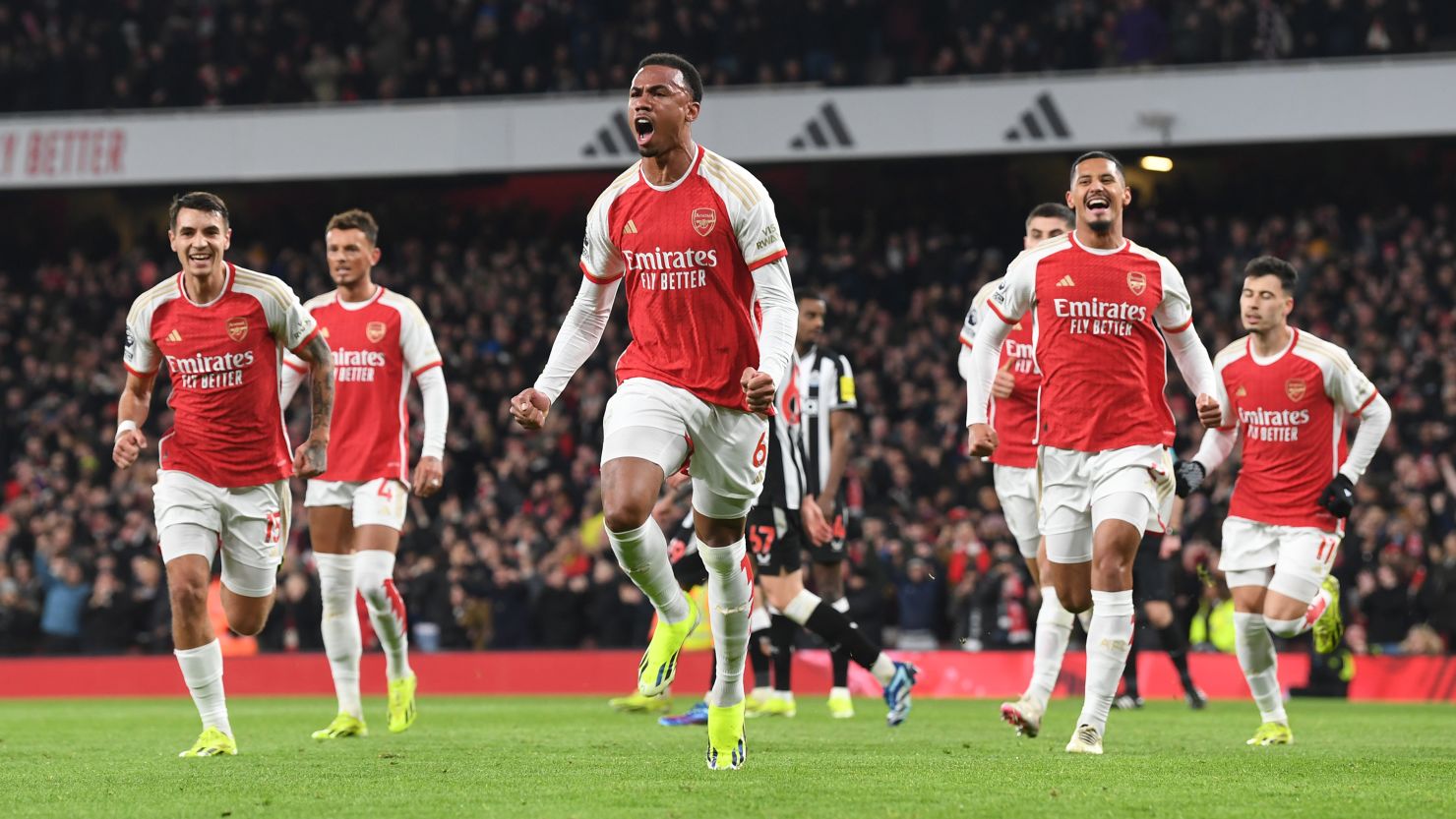Arsenal continues to invest heavily in top talent, maintaining one of the highest wage bills in English football. The club’s salary structure reflects their ambition to compete at the Premier League’s highest level while building a squad capable of challenging for major trophies.
Arsenal Player Salaries
Summary Statistics:
- Arsenal Weekly Payroll: £3,446,350
- Arsenal Annual Payroll: £177,870,500
- Arsenal Average Annual Salary: £6,841,173
| Player Name | Weekly Salary | Annual Salary | Contract Expiration |
|---|---|---|---|
| Bukayo Saka | £300,000 | £15,600,000 | 2027 |
| Kai Havertz | £275,000 | £13,200,000 | 2028 |
| William Saliba | £250,000 | £13,000,000 | 2030 |
| Declan Rice | £225,000 | £11,700,000 | 2028 |
| Martin Ødegaard | £220,000 | £11,440,000 | 2028 |
| Gabriel Jesus | £220,000 | £11,440,000 | 2027 |
| Viktor Gyökeres | £200,000 | £10,400,000 | 2030 |
| Gabriel Martinelli | £180,000 | £9,360,000 | 2027 |
| Eberechi Eze | £175,000 | £9,100,000 | 2030 |
| Gabriel Magalhães | £150,000 | £7,800,000 | 2029 |
| Ben White | £150,000 | £7,800,000 | 2028 |
| David Raya | £120,000 | £6,000,000 | 2028 |
| Riccardo Calafiori | £105,000 | £5,460,000 | 2029 |
| Mikel Merino | £105,000 | £5,460,000 | 2028 |
| Piero Hincapié | £100,000 | £5,200,000 | 2029 |
| Martín Zubimendi | £100,000 | £5,200,000 | 2030 |
| Leandro Trossard | £100,000 | £5,200,000 | 2026 |
| Jurrien Timber | £90,000 | £4,680,000 | 2028 |
| Christian Nørgaard | £80,000 | £4,160,000 | 2027 |
| Kepa Arrizabalaga | £75,000 | £3,900,000 | 2028 |
| Noni Madueke | £75,000 | £3,900,000 | 2030 |
| Cristhian Mosquera | £70,000 | £3,640,000 | 2030 |
| Ethan Nwaneri | £40,000 | £2,080,000 | 2030 |
| Myles Lewis-Skelly | £40,000 | £2,080,000 | 2030 |
| Jack Porter | £1,000 | £52,000 | 2028 |
| Max Dowman | £350 | £18,500 | 2026 |
Arsenal’s Total Wage Bill
The Gunners command significant financial resources to maintain their competitive squad. Arsenal’s current wage bill stands at £177.9 million annually for the 2025/26 season, placing them second in the Premier League behind only Manchester City.
This substantial investment demonstrates the club’s commitment to retaining elite players and attracting world-class talent to North London.
The weekly payroll reaches approximately £3.45 million, with an average player salary of £132,600 per week. This figure represents the highest average salary in the Premier League, showcasing Arsenal’s willingness to reward their talented squad appropriately.
Top Earners at Arsenal
Bukayo Saka leads the Arsenal salary rankings with his £300,000 per week contract, translating to £15.6 million annually. The English winger signed his current four-year deal in May 2023, receiving a significant increase from his previous £70,000 weekly wage.
His contract runs until 2027, though discussions are ongoing for a further extension that could see him become the club’s highest earner at close to £300,000 weekly or potentially higher.
Kai Havertz follows as the second-highest paid player at £275,000 per week (£13.2 million annually). The German midfielder joined Arsenal from Chelsea and his substantial wages reflect his importance to Mikel Arteta’s system.
William Saliba ranks third on £250,000 weekly following his contract extension in June, which made him one of the club’s best-compensated defenders.
Declan Rice earns £225,000 weekly (£11.7 million per year), while captain Martin Ødegaard and striker Gabriel Jesus both receive £220,000 per week. These six players form the core of Arsenal’s highest-paid group, each earning over £11 million annually.
FAQs
1. Who is the highest-paid player at Arsenal?
Bukayo Saka currently earns the most at Arsenal with his £300,000 weekly salary, totaling £15.6 million per year. The 24-year-old England international signed his current contract in May 2023, which represented a massive increase from his previous £70,000 weekly wage. His deal runs until 2027, and Arsenal is actively working on a contract extension that could make him earn even more, potentially approaching or exceeding £300,000 weekly. Saka’s importance to the team both on and off the pitch justifies his position as the club’s top earner.
2. What is Arsenal’s total wage bill for 2025/26?
Arsenal’s wage bill for the 2025/26 season stands at £177.9 million annually. This places them second in the Premier League, behind only Manchester City’s £209.7 million. The weekly payroll reaches approximately £3.45 million across the entire squad. With 26 players in the active squad, the average annual salary per player is £132,600 weekly, which represents the highest average in the Premier League. This substantial investment reflects Arsenal’s commitment to competing for major honors and retaining their best talent despite interest from European rivals.
3. How does Arsenal’s wage bill compare to other Premier League clubs?
Arsenal sits second among Premier League clubs with their £177.9 million wage bill, positioned between Manchester City (£209.7 million) and Liverpool (£162.3 million). Chelsea follows closely at £151.7 million, while Manchester United operates with £144 million in annual player wages. Tottenham maintains a £127.6 million wage bill, and Aston Villa has reached £111.7 million. The financial hierarchy generally reflects competitive standing, with higher wage bills correlating to better league positions and European qualification. Arsenal’s position demonstrates their financial strength within English football’s elite tier.
4. Which Arsenal players earn over £200,000 per week?
Six Arsenal players currently earn at least £200,000 weekly. Bukayo Saka leads at £300,000, followed by Kai Havertz on £275,000 and William Saliba at £250,000. Declan Rice receives £225,000 per week, while both Martin Ødegaard and Gabriel Jesus earn £220,000 weekly. Viktor Gyökeres rounds out this elite group at £200,000 per week. These seven players represent the core of Arsenal’s squad and their combined salaries account for a significant portion of the club’s total wage bill. Their compensation reflects their status as key contributors to the team’s title ambitions.
5. When does Bukayo Saka’s contract expire?
Saka’s current contract runs until 2027. However, Arsenal is prioritizing a contract extension to secure his long-term future at the Emirates. Discussions between the club and Saka’s representatives have been ongoing for over 12 months, with both parties reportedly optimistic about reaching an agreement. The proposed new deal could extend through 2030 and would make him Arsenal’s highest earner, potentially surpassing the £300,000 weekly mark. Sporting director Andrea Berta wants the extension finalized before it becomes a pressing issue in his final contract year.
6. How much do Arsenal’s young players earn?
Arsenal invests in youth development with varying salary levels. Promising teenagers Ethan Nwaneri and Myles Lewis-Skelly each earn £40,000 weekly despite their young ages, with contracts running until 2030. This reflects the club’s belief in their potential and desire to secure their futures. However, younger academy prospects receive much more modest compensation. Jack Porter earns £1,000 weekly at age 17, while 15-year-old Max Dowman receives just £350 per week. This tiered structure allows the club to reward developing talent while avoiding excessive financial commitments to unproven players. As youngsters progress and earn first-team opportunities, they receive significant salary increases.
7. What are the Premier League’s Financial Fair Play rules?
The Premier League operates under Profit and Sustainability Regulations (PSR), which allow clubs to lose up to £105 million over a three-year rolling period. Clubs that spend time outside the top division face a lower threshold of £39 million. Penalties for breaching these limits include point deductions and fines, as seen with Everton, Nottingham Forest, and Leicester in recent seasons. The current system will remain for 2025/26, though changes are planned for 2026/27 that would limit clubs to spending 85% of their income on wages, transfers, and agent fees. These regulations aim to promote financial sustainability and prevent clubs from spending beyond their means.
8. How do Arsenal salaries compare to La Liga wages?
Arsenal’s wage bill significantly exceeds most La Liga clubs. While Real Madrid leads Spanish football with a €284.3 million (approximately £240 million) wage bill, Arsenal’s £177.9 million compares favorably to Barcelona’s €209.4 million (roughly £177 million). The gap widens dramatically with mid-table La Liga sides. Ten Spanish clubs maintain wage bills below €30 million annually—less than 17% of Arsenal’s spending. The Premier League’s superior broadcasting revenue allows English clubs to offer substantially higher salaries. Real Madrid pays Kylian Mbappé more annually than 14 entire La Liga wage bills combined, illustrating the financial disparity within Spanish football compared to the more evenly distributed wealth in England.
9. How do Serie A salaries compare to Arsenal wages?
Serie A operates with considerably lower wage bills than the Premier League. Inter Milan tops Italian football at €140.7 million, followed by Juventus (€121.8 million) and Napoli (€117.1 million). Arsenal’s £177.9 million wage bill exceeds all Serie A clubs when converted to euros. The average Serie A salary stands at approximately €1.5 million per season, far below Arsenal’s average of £6.8 million annually per player. Juventus striker Dušan Vlahović leads Serie A with €22.5 million yearly, comparable to some Arsenal stars but exceptional by Italian standards. The financial gap reflects broader differences in broadcasting revenue and commercial income between England and Italy, giving Premier League clubs significant advantages in player recruitment and retention.
10. Will Arsenal increase their wage bill further?
Arsenal’s wage bill will likely grow as they pursue contract extensions for key players. Bukayo Saka’s anticipated new deal could add several million pounds annually to the total. The club also needs to address expiring contracts for Gabriel Jesus, Gabriel Martinelli (both 2027), and Leandro Trossard (2026). Any significant transfer activity would impact the wage bill, particularly if Arsenal signs additional star players to strengthen their title challenge. However, the club must balance ambition with Financial Fair Play compliance. Arsenal’s strategy involves measured growth rather than reckless spending, maintaining competitiveness while ensuring long-term financial sustainability. The wage bill may increase moderately, but dramatic jumps seem unlikely given the club’s disciplined approach to squad building.












